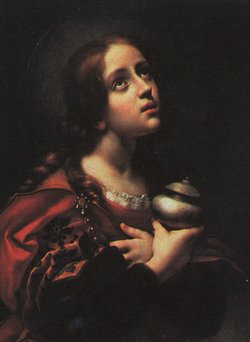Carlo Dolci
|
|
Carlo (or Carlino) Dolci (May, 1616 - January, 1686), Italian painter, was born in Florence. He was the grandson of a painter on his mother's side and became a disciple of Jacopo Vignali.
When he was only eleven years old, he attempted to paint a whole St John and a head of the infant Christ. The head received extraordinary praise. Afterwards, he painted a portrait of his mother, which displayed a new and delicate style. This style brought him into notice and procured him extensive employment in Florence (where he lived) and other parts of Italy.
Dolci bestowed much labour on his pictures, working remarkably slow. It is said that in 1682, when he saw Luca Giordano do more work in four or five hours than he could have done in as many months, he fell into a state of hypochondria. This compelled him to relinquish his art, and soon brought him to the grave.
Dolci's works are not very numerous. He used pencil chiefly for sacred subjects, and generally painted in a small size, although he made a few life-size pictures. He died in Florence, leaving a daughter named Agnese, who arrived at some degree of excellence in copying the works of her father.
Dolci holds somewhat the same rank in the Florentine that Sassoferrato does in the Roman school. Without the possession of much genius, invention or elevation of type, both these artists produced highly wrought pictures, considered extremely attractive by some. The works of Dolci are easily distinguishable by the delicacy of the composition, and by an agreeable tint of colour, improved by judicious management of the chiaroscuro, which gives his figures a striking relief; he affected the use of ultramarine, much loaded in tint. "His pencil," says Pilkington, "was tender, his touch inexpressibly neat, and his colouring transparent; though he has often been censured for the excessive labour bestowed on his pictures, and also for giving his carnations more of the appearance of ivory than the look of flesh."
His best productions are of a devout description: they frequently represent the patient suffering of Christ or the sorrows of the Mater Dolorosa. Dolci was, from a young age, exceedingly pious; it is said that during Passion week every year, he painted a half-figure of the Saviour. His sacred heads are marked with pathetic or at least strongly sentimental emotion. There is a want of character in his pictures, and his grouping lacks harmonious unison, but the general tone accords with the idea of the passion portrayed.
Among the best works of this master are the "St Sebastian"; the "Four Evangelists," at Florence; "Christ Breaking the Bread," in the marquess of Exeter's collection at Burleigh; the "St Cecilia" in Dresden; an "Adoration of the Magi"; and especially "St Andrew praying before his Crucifixion," in the Pitti gallery, his most important composition, painted in 1646; also several smaller pictures, which are highly valued, and occupy honorable places in the richest galleries.
This entry was originally from the 1911 Encyclopedia Britannica.sv:Carlo Dolci

